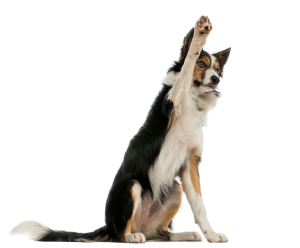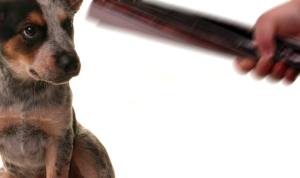 Just waking up from a nap, the 2 month old puppy is now replenished and full of energy. Since he’s locked up in a crate, little Jake starts vocalizing and scratching at the door. Thankfully, Coleen, hearing her pup in the other room, hurries her way over and lets him out. What did the puppy learn? Vocalizing and scratching gets him out of the crate. Jake will most likely do it again when faced with a closed door. Where classical conditioning pairs two stimuli together (like the sound of a clicker and food), operant conditioning refers to the association between a behavior and its consequence. When dealing with living creatures of any kind, understanding how our reactions can influence the strength, the form and the frequency of their behaviors can make a difference between an easy and rewarding relationship; or a challenging and sometimes impossible living situation. Coleen’s intent was certainly not to teach Jake that barking and scratching works. But as Bob Bailey often says, dogs learn whether we want it or not. With better understanding of operant conditioning, we can influence what they learn and deliberately teach them the basics of living in a human environment.
Just waking up from a nap, the 2 month old puppy is now replenished and full of energy. Since he’s locked up in a crate, little Jake starts vocalizing and scratching at the door. Thankfully, Coleen, hearing her pup in the other room, hurries her way over and lets him out. What did the puppy learn? Vocalizing and scratching gets him out of the crate. Jake will most likely do it again when faced with a closed door. Where classical conditioning pairs two stimuli together (like the sound of a clicker and food), operant conditioning refers to the association between a behavior and its consequence. When dealing with living creatures of any kind, understanding how our reactions can influence the strength, the form and the frequency of their behaviors can make a difference between an easy and rewarding relationship; or a challenging and sometimes impossible living situation. Coleen’s intent was certainly not to teach Jake that barking and scratching works. But as Bob Bailey often says, dogs learn whether we want it or not. With better understanding of operant conditioning, we can influence what they learn and deliberately teach them the basics of living in a human environment.
What would happen if we placed a cat in a puzzle box (see video below)? Undoubtedly, the cat would immediately try to get out. The cat will scratch, stretch it’s paws through openings, meow, press on different levers, etc. What Konorski, and then Thorndike realized in the late 1800s to mid 1900s, was that once they’ve escaped, if they’re placed in the box again and again they will be quicker and quicker at getting out. Well, that makes sense you might think, and seems pretty obvious. The cats gradually learn which behaviors work and which ones don’t. The behaviors that help the cat to get out will be repeated, and the others will gradually be abandoned. This Law of effect is very logical. Unfortunately, we often fall short of realizing how much it impacts our behavior as well as that of those around us. Little puppy Jake is no different than these cats but his situation was a little different and what worked for him was to vocalize and scratch.
 These observations later led Skinner to develop a series of experiments to identify the laws at work. By placing rats or pigeons in different boxes, he was able to manipulate the conditions and consequences of their behavior. He brought to light a number of learning principles that are true for any living being with a central nervous system. Most animal training today is a direct application of his work. For purpose of clarity, I will use examples of how this applies to humans also.
These observations later led Skinner to develop a series of experiments to identify the laws at work. By placing rats or pigeons in different boxes, he was able to manipulate the conditions and consequences of their behavior. He brought to light a number of learning principles that are true for any living being with a central nervous system. Most animal training today is a direct application of his work. For purpose of clarity, I will use examples of how this applies to humans also.
Since behavior is influenced by its consequence, lets take a closer look at the types of consequences and how they will affect the behavior. There are three main categories of consequences:
- Neutral: If we press on a button that triggers a soft whistle, how likely are we to do it again? There would probably be a 50/50 chance that we would press that button again. The experience is neither pleasant nor unpleasant. In this case, the consequence has no effect on our behavior.
- Reinforcer: Saying ‘thank you’ to the clerk, gets us a smile in return; giving money at the drive through, gives us our favorite drink and opening Jake’s crate, stopped the annoying vocalizing. In all these situations, the consequence of each one of these behaviors, led to a positive outcome. Our behavior is likely to be repeated and over time, become a habit.
- Punisher: Why don’t we stick our hand on a hot surface? At some point in our life, we learned that to be a painful experience! We slow down at the sight of a police car or make sure to show up at work on time for the same reasons. The consequences to being late, speeding when in presence of a police officer or touching something hot, all taught us to avoid repeating those behaviors.
Let’s look at a few consequences that will generally increase or decrease behavior (in no particular order):
Reinforcers:
- For people: praise, money, attention, food, safety, comfort.
- For dogs: food, attention, toy, praise, safety, comfort
Punishers:
- For people: prison, being scolded, getting a ticket, social rejection
- For dogs: loud and sudden noise, being scolded or hit, restraint, electric shock
Most of us understand these basic principles and much of our dealings with others is based on the idea that we reward the behaviors that we like and punish those that we don’t like. Unfortunately we often fail to realize that reinforcement and punishers are never absolute qualities. What’s reinforcing to some people or animals, may not be to others. I would think that most of us love chocolate and would easily view chocolate as a reinforcer, but I also know people who either don’t care for it or have allergic reactions to it (in which case chocolate would be a punisher). In other words, what qualifies for a reinforcer or a punisher is only dictated by its effects on the behavior, not on how pleasant or unpleasant it appears to us! So if I pat my dog on the head or give her a hug to reward her for sitting quietly, have I really reinforced her behavior? Not necessarily. In fact, most dogs don’t appreciate being hugged or patted on the head. A quick look at my dog’s reaction should let me know that I may have actually punished her!! What will really let me know how she received the consequence I gave her, is whether she will increase that behavior, decrease it, or won’t change it at all.
 The other question that we often struggle with is this: what are we really reinforcing or punishing? A common example that many dog guardians get caught up in is the idea that dogs should be punished if they don’t come when called. So when Fido finally decides to leave the smell he was busy analyzing to come over to us, he gets grabbed by the collar and yelled at. What was really punished? Coming over to us. The dog is now going to hesitate even more next time we call him. The same applies to peeing on the carpet. When we come home, our gut belief is that we have to punish the perpetrator of the deed or he’ll do it again. What are we really punishing? Again, we’re punishing the dog for coming to us and displaying submission in order to appease our thrash, not the behavior that happened minutes if not hours ago.
The other question that we often struggle with is this: what are we really reinforcing or punishing? A common example that many dog guardians get caught up in is the idea that dogs should be punished if they don’t come when called. So when Fido finally decides to leave the smell he was busy analyzing to come over to us, he gets grabbed by the collar and yelled at. What was really punished? Coming over to us. The dog is now going to hesitate even more next time we call him. The same applies to peeing on the carpet. When we come home, our gut belief is that we have to punish the perpetrator of the deed or he’ll do it again. What are we really punishing? Again, we’re punishing the dog for coming to us and displaying submission in order to appease our thrash, not the behavior that happened minutes if not hours ago.
Once we have identified the consequences that will either reinforce/strengthen or punish/weaken the behavior, we can add two other categories; the consequences that we add, and those that we remove. To qualify those categories, we use mathematical symbols. When something is added, it’s positive (+), when something is removed, it’s negative (-).
Let’s take a few examples. When the dog sits and we give him a treat, we add something that wasn’t there before the behavior: the treat. Similarly, if we hit the dog, we also add something. (Notice, hitting the dog is called positive, not because we judged the action as a morally positive action but because it was an added behavior or thing.) In both cases, we’ll refer to these consequences as being positive. On the opposite side, when we take away our attention when our dog barks at us, or we remove the pressure on the leash when the dog stops pulling, these consequences would be negative. So in this context, the terms positive or negative have nothing to do with the consequences being pleasant or unpleasant, they only indicate whether we add or take away something as a consequence to a behavior.
So we can categorize the consequences to any behavior into 4 categories when we put it all together:
|
Reinforcers |
Punishers |
|
|
Positive |
When the behavior happens, something is added (+) that will strengthen the behavior. It will be more likely to happen again. R+ |
When the behavior happens, something is added (+) that will weaken the behavior, and make it less likely to happen again. P+ |
|
Negative |
When the behavior happens, something is removed (-) that will strengthen the behavior, and will make it more likely to happen again. R- |
When the behavior happens, something is removed (-) that will weaken the behavior, and will make it less likely to happen again. P- |
Another way to look at it:
|
A treat |
An aversive |
|
|
We Add |
Positive reinforcement (R+) |
Positive punishment (P+) |
|
We remove |
Negative punishment (P-) |
Negative reinforcement (R-) |
Emotional effects
|
A treat |
An aversive |
|
|
We add |
Positive reinforcement Satisfaction |
Positive punishment Anxiety |
|
We remove |
Negative punishment Frustration |
Negative reinforcement Relief |
We’ll go into the details and effects of each one of these 4 categories of consequences in future posts. What I was mostly trying to convey here is that what we think affects behavior and what really happens may be two different things. With a more systematic approach however, we can get better at identifying what is influencing our animal’s behavior and sometimes too, better understand our own reactions. The results we’ll ultimately get with our dog will depend on how we react to their behavior. Let’s choose our consequences wisely!
Jennifer Cattet Ph.D.



easy to follow the explanation of positive and negative re-inforcers , thanks much clearer now
Where you wrote “What was really punished? Coming over to us.”, you point out the common mistake of interpreting an action only in your own logic or intent, but people also make the mistake of always applying statements such as that one as a rule. However, the result can only be accurately interpreted by the dogs subsequent behavior in similar situations in the future.
For the dog peeing, your body language and manner of calling him to you may have been sufficiently different from normal such that the dog will relate it to the inappropriate urination and not punishing the “come”. Maybe so, or maybe not, but only subsequent behavior can accurately answer that question.
People tend to like simple and strict rules, but reinforcement and punishment are defined by consequences.
The articles presented here are excellent, I refer to many as I am teaching future Service Dog Trainers, thank-you
Thank you for your feedback. I’m glad you enjoy the blogs and that you find use for them in your teaching. Please let us know if there are any particular subjects that you would like to see me blog about. Best regards, Jennifer